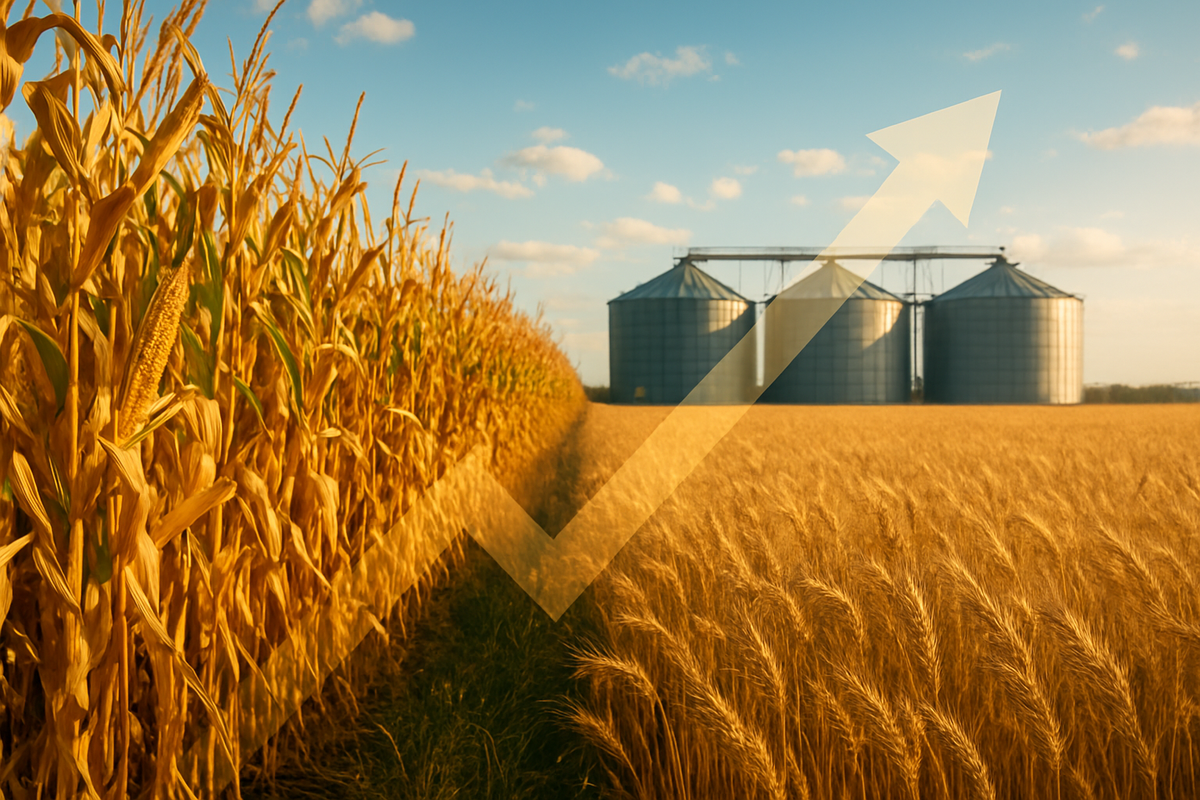
Chicago, IL – November 5, 2025 – In a perplexing turn for agricultural markets, CBOT Corn futures have demonstrated an unexpected upward trajectory, significantly bolstered by a robust performance in wheat futures. This rally unfolds against a backdrop of what appears to be an ample global supply of both grains, presenting a complex scenario for traders, farmers, and consumers alike. The immediate implications point to heightened market volatility and a re-evaluation of demand-side dynamics, even as harvest season concludes and storage bins are projected to be full.
This counter-intuitive price movement suggests that short-term market sentiment, driven by specific demand signals and underlying concerns, is temporarily outweighing the fundamental indicators of supply. For the broader financial audience, this event signals a period of uncertainty and potential opportunity, challenging conventional wisdom regarding commodity pricing in a well-supplied market.
Unpacking the Unexpected Rally in Grain Markets
As of November 5, 2025, CBOT Corn futures for the December 2025 contract (ZCZ25) have seen a notable rise, closing at approximately $4.35 per bushel, up 0.87%. This marks a 1.01% increase from the previous day and a 3.11% gain over the past month. This upward movement has pushed corn prices to levels not seen since June. Simultaneously, CBOT Wheat futures for December 2025 (ZWZ25) have exhibited even stronger momentum, surging 0.82% to $5.54 per bushel, representing an 8.09% increase over the last month and reaching their highest point since July.
Several factors are converging to fuel this rally despite robust supply forecasts. For corn, strong weekly U.S. export inspections are depleting near-term physical availability, while high ethanol production and exports are maintaining domestic demand. Globally, excluding China's strategic stockpiles, inventories are lean, contributing to one of the smallest stocks-to-use cushions in decades. Furthermore, deteriorating weather conditions in South America, particularly dryness in central Brazil and parts of Argentina, are raising concerns for upcoming safrinha plantings and the crucial second-crop flows in the next year. Recent interruptions in official U.S. data releases have also amplified market sensitivity to real-time weather and shipment signals.
The strength in wheat futures is largely attributed to a resurgence in Chinese demand. Reports indicate a major Chinese grains importer is inquiring about U.S. wheat cargoes for December-February shipment, following a recent trade truce. This renewed interest, despite China's reduced overall wheat imports in the past nine months, is a significant bullish driver. Concerns over tighter global supply, influenced by export challenges in Russia and Ukraine, and potential adverse weather impacts on crops, further underpin the price increase. However, the paradox remains: StoneX projects a record-setting U.S. corn yield of 186.0 bushels per acre for 2025, and global wheat supply is robust, with Russia forecasting a near-record 2025 wheat crop. This suggests that current price increases are heavily influenced by short-term demand shocks, regional weather concerns, and speculative trading rather than a fundamental global shortage.
Corporate Fortunes: Winners and Losers in a Rising Grain Market
The current surge in corn and wheat futures is poised to create a distinct cleavage between public companies, with some poised to benefit significantly while others face mounting cost pressures.
The Potential Winners: Companies directly involved in grain production, merchandising, and agricultural inputs stand to gain. Archer-Daniels-Midland (NYSE: ADM), a global leader in agricultural processing and commodities trading, could see improved revenues from its merchandising and processing segments as commodity values increase. Similarly, Bunge Global SA (NYSE: BG), another agribusiness giant, is likely to benefit from higher grain trading revenues. Grain elevator operators and merchandisers like The Andersons, Inc. (NASDAQ: ANDE) could also experience a boost. Farmers, in general, will find favorable pricing opportunities for their existing inventories. This positive sentiment could extend to agricultural equipment manufacturers like Deere & Company (NYSE: DE), as farmers, encouraged by better prices, might invest more in new machinery and technology to maximize future yields. Seed and crop protection companies such as Corteva, Inc. (NYSE: CTVA) and fertilizer producers like CF Industries Holdings, Inc. (NYSE: CF) could also see increased demand for their products.
The Potential Losers: Conversely, companies that rely on corn and wheat as primary raw materials will face increased input costs, potentially squeezing profit margins. The food processing industry is particularly vulnerable. Major food conglomerates like Kellogg's (NYSE: K) and General Mills (NYSE: GIS), whose product portfolios are heavily dependent on corn and wheat derivatives (e.g., cereals, snacks, flour-based goods), will contend with higher ingredient expenses. Ingredient solutions providers like Ingredion Inc. (NYSE: INGR), which converts plant-based materials into starches and sweeteners, will also feel the pinch. The livestock industry is another significant consumer of corn for animal feed. Companies such as Tyson Foods (NYSE: TSN), a major producer of beef, pork, and poultry, will see their feed costs rise, directly impacting their cost of goods sold. Finally, ethanol producers, which use corn as their primary feedstock, will face direct pressure on profitability. Companies like Rex American Resources (NYSE: REX), Valero Energy Corporation (NYSE: VLO), and Green Plains, Inc. (NASDAQ: GPRE) could see margins tighten unless they can effectively pass on these increased costs or if ethanol prices rise commensurately.
Broader Implications: A Shifting Agricultural Landscape
This current market dynamic, where futures prices defy ample supply, signals a broader underlying shift in the agricultural landscape, influenced by several interconnected trends. Firstly, the event highlights the growing impact of geopolitical risks. Ongoing conflicts, particularly in the Black Sea region, continue to inject volatility into global grain markets, creating supply chain uncertainties that traders are quick to price in. The recent U.S.-China trade developments, while offering a glimmer of hope for demand, also underscore the fragility of international trade relations and their immediate effect on commodity flows.
Secondly, climate variability is increasingly becoming a dominant factor. Despite overall robust global supply forecasts, localized adverse weather conditions, such as the dryness in South America, can trigger significant price reactions. This emphasizes that global supply figures can mask regional vulnerabilities, making markets highly sensitive to even minor weather-related disruptions. This trend points to a future where agricultural production is more susceptible to extreme weather events, demanding greater resilience and adaptation strategies.
Regulatory and policy implications are also at play. The impact of the recent U.S. government shutdown, which temporarily halted the release of critical agricultural data, demonstrated how a lack of transparency can exacerbate market uncertainty and price swings. Furthermore, biofuel mandates, particularly in the U.S., continue to exert a strong influence on corn demand, linking agricultural prices to energy policy. Historically, similar periods of price surges, such as those in the 2006-2008 and 2020-2022 periods, were driven by a confluence of strong demand, supply shocks, increased biofuel demand, and currency movements. While the current situation shares some of these characteristics, the pervasive influence of climate change and heightened geopolitical tensions adds new layers of complexity, suggesting that these price movements might be more frequent and less predictable than in the past.
The Road Ahead: Navigating Volatility and Opportunities
Looking ahead, the short-term outlook for CBOT Corn and Wheat futures suggests continued volatility. While some analysts project corn to trade around $4.35-$4.60 per bushel by the end of 2025, with potential rallies to $4.75-$5.00 in 2026 driven by consumption growth, the record U.S. production and surging ending stocks present an oversupply dilemma. For wheat, despite current gains, a global supply glut, particularly from Russia's record harvest and zero-tax export policy, could exert downward pressure, with forecasts ranging from $4.90-$5.25 per bushel in the coming months.
In the long term, climate change remains the paramount influence, reshaping agricultural production with altered rainfall patterns and more frequent extreme weather events. This will necessitate significant strategic pivots across the agricultural sector. Farmers will need to adopt more resilient crop varieties and implement sustainable practices. Agricultural businesses must diversify markets and invest in supply chain resilience to mitigate future disruptions. Governments will play a crucial role through policies promoting adaptation and ensuring food security.
Potential scenarios include a continuation of geopolitical volatility and climate extremes, leading to persistent price volatility and upward pressure on futures, exacerbating food insecurity. Alternatively, a global production oversupply coupled with weakening demand could see prices trend downwards, creating significant margin pressure for producers. An optimistic scenario involves successful adaptation and stable growth through technological advancements and effective international cooperation, leading to more predictable markets. Investors should watch for the USDA's upcoming WASDE report on November 14th for updated supply and demand figures, which could provide clearer direction amidst these mixed signals.
Concluding Thoughts: A Market in Flux
The recent surge in CBOT Corn and Wheat futures, despite indicators of ample supply, underscores the intricate and often unpredictable nature of global commodity markets. Key takeaways from this event include the significant impact of short-term demand shocks, the growing influence of geopolitical tensions and climate variability, and the resulting heightened market sensitivity. While fundamental supply figures suggest a well-supplied market, the interplay of these factors can quickly override long-term projections, leading to rapid price adjustments.
Moving forward, the market is likely to remain in flux, characterized by periods of sharp price movements in response to new information regarding weather, trade policies, and geopolitical events. For investors, this environment presents both challenges and opportunities. A keen focus on hedging strategies, diversification, and staying abreast of real-time market intelligence will be crucial. The lasting impact of this period will likely be a reinforced understanding of the interconnectedness of global food systems and the imperative for greater resilience and adaptability in agricultural practices worldwide.
This content is intended for informational purposes only and is not financial advice





